8 Most Sustainable Golf Clothing Brands: The Conscious Consumer’s Guide
Affiliate Disclosure
Hey fellow impactful ninja ?
You may have noticed that Impactful Ninja is all about providing helpful information to make a positive impact on the world and society. And that we love to link back to where we found all the information for each of our posts.
Most of these links are informational-based for you to check out their primary sources with one click.
But some of these links are so-called "affiliate links" to products that we recommend.
Why do we add these product links?
First and foremost, because we believe that they add value to you. For example, when we wrote a post about the environmental impact of long showers, we came across an EPA recommendation to use WaterSense showerheads. So we linked to where you can find them. Or, for many of our posts, we also link to our favorite books on that topic so that you can get a much more holistic overview than one single blog post could provide.
And when there is an affiliate program for these products, we sign up for it. For example, as Amazon Associates, we earn from qualifying purchases.
What do these affiliate links mean for you?
First, and most importantly, we still only recommend products that we believe add value for you.
When you buy something through one of our affiliate links, we may earn a small commission - but at no additional costs to you.
And when you buy something through a link that is not an affiliate link, we won’t receive any commission but we’ll still be happy to have helped you.
What do these affiliate links mean for us?
When we find products that we believe add value to you and the seller has an affiliate program, we sign up for it.
When you buy something through one of our affiliate links, we may earn a small commission (at no extra costs to you).
And at this point in time, all money is reinvested in sharing the most helpful content with you. This includes all operating costs for running this site and the content creation itself.
What does this mean for me personally?
You may have noticed by the way Impactful Ninja is operated that money is not the driving factor behind it. It is a passion project of mine and I love to share helpful information with you to make a positive impact on the world and society. However, it's a project in that I invest a lot of time and also quite some money.
Eventually, my dream is to one day turn this passion project into my full-time job and provide even more helpful information. But that's still a long time to go.
Stay impactful,
Amid growing concerns about the textile industry’s environmental impact, there is pressure to find greener clothes for the office as well as the sports field—or the gold course, in this case. Unfortunately, fashion greenwashing makes it harder for you and other consumers to figure out which clothing brands offer the most eco-friendly golf apparel. So, we had to ask: Which are the most sustainable golf brands?
The most sustainable golf clothing brands are Reflo, Definite Articles, and Galvin Green, which use innovative materials that are low-impact and high-performing while reducing waste. As well, Allbirds and Tentree use natural fibers to make plastic-free clothing items and strive for circularity.
Whether you are searching for a perfectly fitting golf skirt or a polo shirt to add to your wardrobe without negatively impacting the soil, the water, the animals, and other people, there is a brand for you. So, let’s keep reading to learn more about the most sustainable golf clothing brands and how they ensure sustainable, ethical practices.
Here’s How We Selected the 8 Most Sustainable Golf Clothing Brands
Golf apparel can have a high environmental impact because the high performance and fitting requirements are often better met by using synthetic fabrics, which don’t biodegrade and release microplastics while using and washing.
“Sustainable: The ability to be maintained at a certain rate or level | Avoidance of the depletion of natural resources in order to maintain an ecological balance”
Oxford Dictionary
The brands on this list were chosen based on their commitment and actions to promote sustainable practices while reducing the environmental impacts of the textile industry.
They are transparent about their materials, processes, and workforce management within their supply chain.
Some brands focus their efforts on reducing waste and optimizing natural resources while others strive to reduce the carbon footprint of their clothes.
All of these brands share the commitment to reshape the textile industry toward a more sustainable and Earth-friendly sector.
These Are the 8 Most Sustainable Golf Clothing Brands
Most Sustainable Golf Clothing Brands
Overall, these golf clothing brands are sustainable. Yet, they take various approaches to reduce environmental impacts and uphold ethical standards. Let’s dive into each brand and find out more.
Reflo: Sustainable Performance Wear Made With Recycled Plastic Yarns

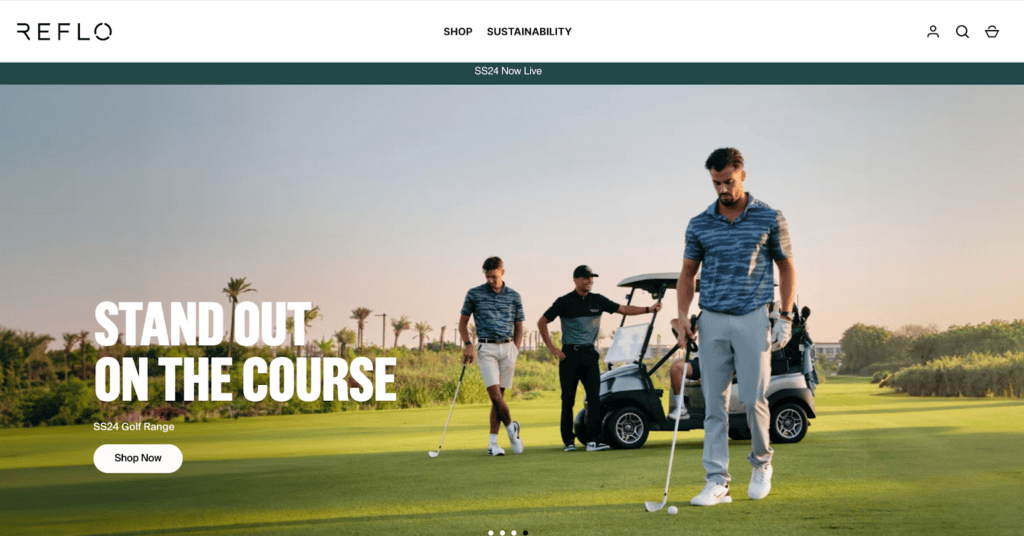
“The clothes literally go through the same process as you would take a plastic bottle to be recycled. It goes through a machine that strips it down, heats it and turns it into pellets. Those pellets can be extracted and turned into a fabric again. So it’s a fully closed-loop system, it’s the first in golf and it’s something we’re incredibly proud of.”
Rory MacFadyento, Founder of Reflo
🌎
How do they ensure their sustainability?
Reflo ensures their sustainability by using low-impact materials, minimizing waste, and reducing climate impact.
- First, they source single-used plastics destined for landfills and discarded coffee grounds to make advanced technical fabrics. The recycled plastic yarns use 50% less energy, 70% fewer carbon emissions, and 20% less water than those based on virgin synthetic polymers. Additionally, thanks to a chemical extracted from coffee grounds incorporated into their recycled polyester yarn, their performance fabric dries 200% faster than cotton. The fabrics they create adhere to multiple sustainability certifications, including Global Recycled Standard, Bluesign®, OEKO-TEX®, and U Trust.
- Secondly, Reflo takes various approaches to minimize waste, including employing alternative pattern-cutting techniques for minimal textile scraps, recycling unused samples into golf club covers or scrunchies, and minimizing packaging with customized boxes and envelopes. Furthermore, their Reloop collection is made from 100% recycled content and recyclable using their Reloop technology, closing the circle in fashion.
- Lastly, Reflo takes action to address their carbon footprint in two key ways: reducing as much as they can and offsetting the entire carbon footprint of their team. Thanks to their partnership with Ecologi, they fund renewable energy and carbon reduction projects around the world.
🌐
How do they ensure their ethics?
Reflo ensures ethical practices by partnering with BSCI-certified manufacturers.
- These manufacturers pay above minimum wage, use no child labor, and keep overtime work optional and at a higher pay rate.
- Their factories are also independently audited.
- Furthermore, the brand contributes to the growth of their textile workers by allocating part of their profits to creating upskill opportunities for people who work in their supply chain.
🤝
Are they part of any giving-back programs?
For every item purchased, Reflo plants a tree in areas devastated by deforestation, such as Madagascar and Mozambique.
🛍️
What is their product range?
- Best for: menswear, womenswear
- Product range: giles, midlayers, hoodies, jackets, polo shirts, shorts, T-shirts, tanks, pants
- Price range: $$$
- Size range: S–XXL
Definite Articles: For Active People Who Love Their Planet

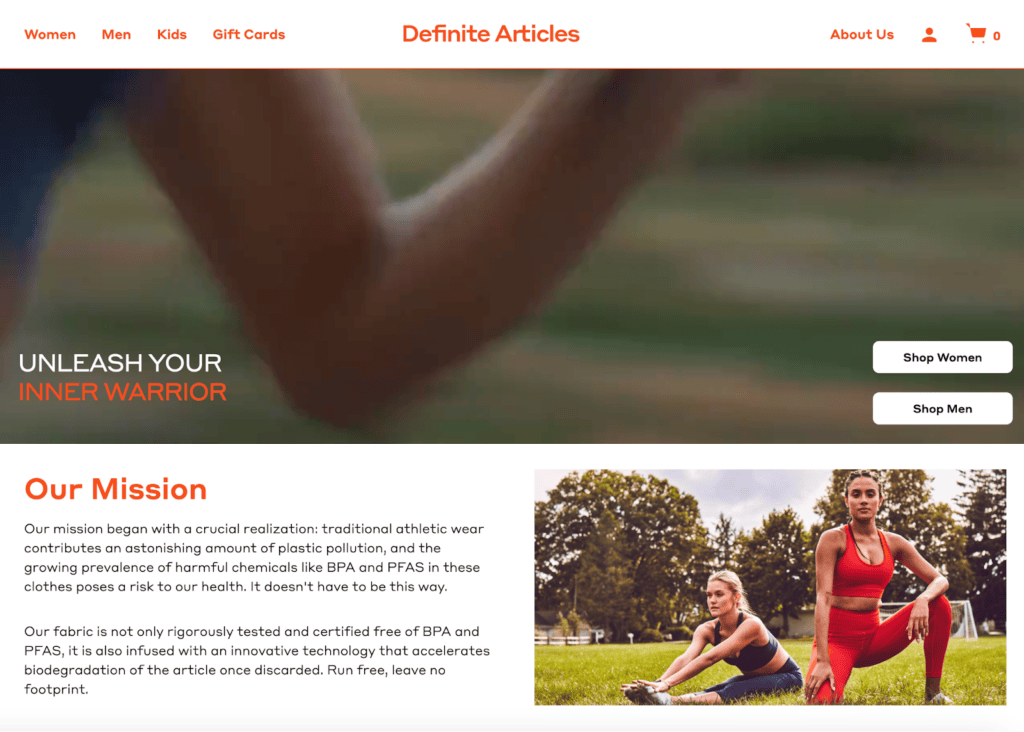
“Our fabric is not only rigorously tested and certified free of forever chemicals like BPA and PFAS, but it is also infused with an innovative technology called CiCLO that significantly accelerates the biodegradation of the garment once discarded, transforming it naturally into soil in just a few years.”
Definite Articles
🌎
How do they ensure their sustainability?
Definite Articles ensures their sustainability firstly by creating the planet’s first biodegradable performance wear to reduce plastic waste and associated pollution.
- In particular, they use the next generation, OEKO-TEX® certified sustainable technology “CiCLO” that enables traditional yarns like nylon and polyester to behave like natural fibers when they end up in the environment and thus biodegrade in two to three years rather than centuries. Additionally, their collection is free of harmful chemicals like BPA and PFAS and partly made with relatively low-impact textiles such as cotton under the Better Cotton Initiative or lyocell.
- Secondly, Definite Articles reduces their climate impact by keeping their entire supply chain locally in the US for a lower transporting carbon footprint. They also opt to pack their orders in carbon-neutral fulfillment centers.
🌐
How do they ensure their ethics?
Definite Articles ensure their ethics by sourcing their fabrics from family-owned mills. Their Supplier Code of Conduct also covers ILO’s Fundamental Principles and Rights at Work.
🤝
Are they part of any giving-back programs?
Definite Articles gives back by planting trees in the US. They are a reforestation partner of One Tree Planted, committing to donations of 2% their annual revenue.
🛍️
What is their product range?
- Best for: womenswear, menswear, kidswear
- Product range: leggings, sports bras, tanks, joggers, hoodies, shorts, shirts, socks
- Price range: $$
- Size range: XS–XL
Galvin Green: High-Tech All-Weather Golf Apparel


“Developing high-performance golf wear is all about translating the best technologies available into a pure performance-driven design, giving the player that extra edge to excel. Each detail is there for a reason – a result of years of experience and a true passion for the game.”
Galvin Green
🌎
How do they ensure their sustainability?
Galvin Green ensures their sustainability by building products that last with the help of smart technology systems.
- Firstly, they strive to keep clothes in circulation for as long as possible, reducing waste and stress on natural resources for making new clothes. Gavin Green achieves this by using durable materials, adopting timeless designs, and promoting care and repair. They apply advanced technology to create high-performance waterproof, windproof, and thermal fabrics for the golf course.
- Additionally, their streamlined sourcing strategy holds the potential to reduce carbon emissions, minimize waste, enhance operational efficiency, and expedite product delivery. Specifically, Galvin Green offers a range made from recycled materials and an Upcycled Collection utilizing most of their leftover fabrics.
- Lastly, the brand takes concrete actions to lower their climate impact. These include installing solar panels, charging electric cars, and arranging electric bike leases for staff. They also set up a local distribution center in the US to curb the number of packages flown daily between their European warehouse and locations in the US to fulfill US orders.
🌐
How do they ensure their ethics?
Galvin Green ensures their ethics by having their suppliers audited and comply with all of the laws of the production countries and the requirements of Galvin Green’s Code of Conduct.
🤝
Are they part of any giving-back programs?
Galvin Green is not known to be part of any giving-back programs.
🛍️
What is their product range?
- Best for: menswear, womenswear, kidswear
- Product range: waterproof, jackets, mid layers, polo shirts, bottoms, base layers, accessories
- Price range: $$$
- Size range: XS–XXL
Allbirds: Simple and Comfortable Footwear Made With Nature-Based Materials


“Reducing the carbon footprint of our products is at the heart of everything we do.”
Allbirds
🌎
How do they ensure their sustainability?
Allbirds ensures sustainability by committing to a concrete plan to achieve net zero carbon by 2030 through meticulously measuring their carbon footprint and working to reduce the emissions beyond carbon neutrality while offsetting the current emissions to operate as a carbon-neutral business.
- They rely on renewable materials, regenerative agriculture, and responsible energy to reduce their carbon footprint. Specifically, Allbirds sources natural and recycled fabrics to replace petroleum-based synthetic textile materials. The brand even invented their own nature-based alternative called SweetFoam®, their shoe sole material derived from the world’s first carbon-negative green EVA (ethylene-vinyl acetate). They’ve also invested in novel solutions, like Plant Leather, a 100% natural, plant-based leather. Additionally, more than 60% of their merino wool currently comes from regenerative agriculture, which has the potential to reverse climate change while promoting biodiversity. Specifically, they combine natural and plant-based fabrics (merino wool, organic cotton, TENCEL™) with recycled synthetic fabrics in their socks.
- Further down the life-cycle, Allbirds actively reduces their carbon footprint in manufacturing and transporting by using renewable energy in their “owned & operated” facilities and their finished goods manufacturers, shipping by boats, and reducing 40% packaging material by using one post-consumer recycled cardboard as a 2-in-1 shoe box/shipping box.
- In spring 2024, Allbirds plans to launch M0.0NSHOT—a net zero carbon shoe (a standard sneaker has an average footprint of about 14 kg CO2 eq).
- Lastly, they encourage buying and selling slightly imperfect and gently used Allbirds products on Allbirds ReRun™ to extend the products’ life-cycle
🌐
How do they ensure their ethics?
Allbirds has a Supplier Code of Conduct, drawing upon ILO Core Labor Standards to ensure safe working conditions, respect and dignity for workers, and environmentally responsible manufacturing processes in their supply chain.
- On top of that, they require independent, third-party social and environmental audits of their Tier 1 suppliers.
- They also strive for transparency and traceability in their supply chain: 100% of their Tier 1 and Tier 2 suppliers are currently mapped with a target to reach 100% supply chain traceability by 2025.
- Additionally, their Animal Welfare Policy ensures their merino wool is held to high farming standards, land management, and animal welfare. Their merino wool is also certified by ZQ Merino, covering sustainability and ethics from farm to fashion.
🤝
Are they part of any giving-back programs?
Allbirds donates slightly used shoes returned by customers to Soles4Souls, an organization that helps to empower people living in poverty by creating jobs for them. During the COVID-19 pandemic, Allbirds supported healthcare workers by donating shoes and running a “buy one, give one” option, enabling customers to get involved and show appreciation for those making a difference.
🛍️
What is their product range?
- Best for: womenswear, menswear, kidswear
- Product range: sneakers, socks
- Price range: $$
- Size range: XS–XXL
Tentree: A Tree-Planting Lifestyle Clothing Brand With a Sportswear Collection

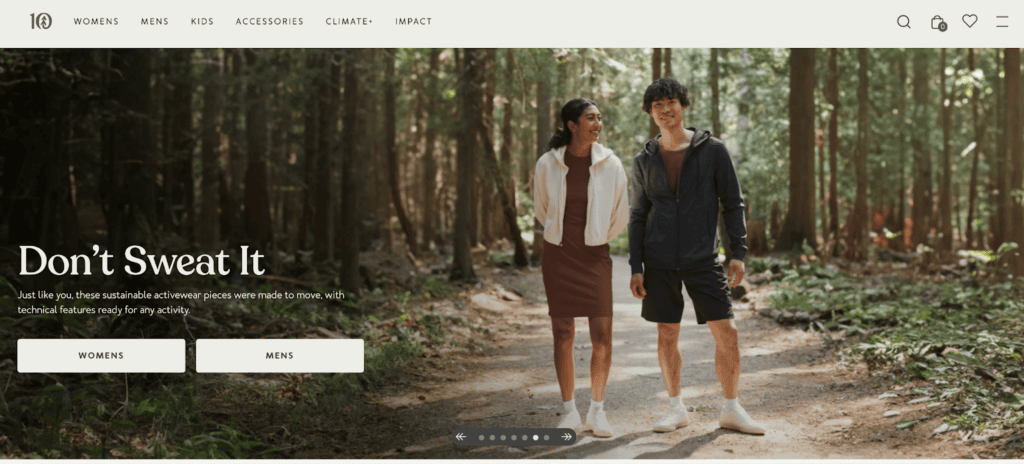
“ We believe the future of business is restorative.”
Tentree
🌎
How do they ensure their sustainability?
Tentree ensures sustainability by planting trees, promoting circularity, opting for low-impact fabrics, and attaining responsible packaging.
- Since their inception, they have planted more than 100,000,000 trees, which helps regenerate ecosystems, capture carbon, and provide forestry jobs in communities around the world. Together with textile recycler SuperCircle and resale guru Treet, Tentree has created an integrated solution to resell or recycle pre-loved Tentree clothing items, keeping them in circulation and out of landfills.
- Tentree also uses eco-friendly fabrics and blends, including organic cotton, hemp, recycled polyester, and TENCEL™. For example, the InMotion Tank is made with recycled polyester (REPREVE®) and is ideal for hitting the gym.
- Regarding packaging, they have replaced all single-use plastics with FSC-certified and 100% recycled paper.
- Finally, they have B Corporation and Climate Neutral certifications.
🌐
How do they ensure their ethics?
Tentree enforces fair labor practices by collaborating only with manufacturers and suppliers that guarantee a safe and respectful environment for their employees.
- They also regularly audit their partner facilities to ensure compliance with their Code of Conduct and international labor standards. Part of their supply chains is certified by organizations that protect workers, such as Fair Wear Foundation, Global Organic Textile Standard, Sedex Members Ethical Trade Audit, and Worldwide Responsible Accredited Production – WRAP.
- Additionally, Tentree commits to protecting forests through their paper, packaging, and fabric choices.
🤝
Are they part of any giving-back programs?
Giving back is a cornerstone of Tentree’s mission. Tentree plants 10 trees worldwide for every item purchased, contributing to reforestation and combating climate change. In 2022 alone, their customers helped plant over 22 million trees across nine countries, restoring over 2,000 hectares of terrestrial forests, over 1,000 hectares of coastal mangrove forests, and hundreds of hectares of marine land.
🛍️
What is their product range?
- Best for: kidswear, menswear, womenswear
- Product range: T-shirts, tank tops, shirts, sweaters, cardigans, dresses, pants, hoodies, dresses, shorts, skirts, joggers, jackets, coats, underwear
- Price range: $$
- Size range: XXS–XXL
WYLD1: Sportswear Built With Precision and Passion

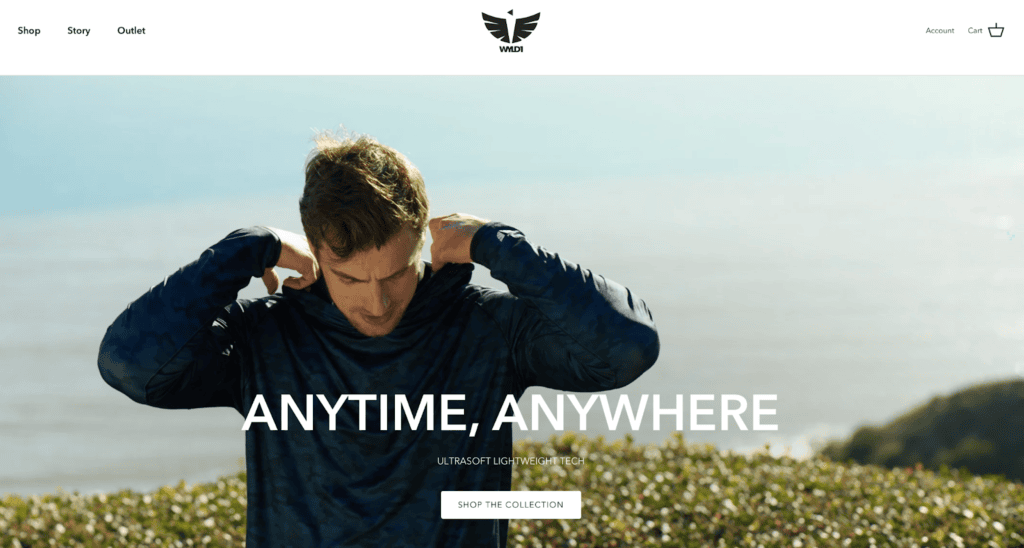
“A golfer led, golfer run brand. From the start, WYLD1 has been committed to making a positive impact on the future of golf and our planet through stewardship and an unwavering pledge to sustainability.”
WYLD1
🌎
How do they ensure their sustainability?
WYLD1 promotes sustainability by making durable and versatile performance garments.
- They achieve that by combining premium, planet-friendly materials with innovative fabric science. WYLD1’s fabric collection is also based on natural fibers like merino wool, Pima cotton, and SeaCell and is furthermore enhanced with advanced technologies like Nano-Active™ for wicking, quick-drying, and breathability, along with Nano-Temp™ for dynamic temperature control, Nato wicking, quick-drying, and breathability, and last but not least, Nano-Defend™ for sun protection.
- Additionally, their design principles focus on high-quality construction, timelessness, and recyclability.
- Lastly, WYLD1 reduces their climate impact by purchasing carbon offsets, powering with renewable energy sources, using recycled materials, and selecting partners with GHG emission reduction practices. Finally, WYLD1 carbon offsets are purchased through Pachama’s Acapa – Bajo Mira y Frontera Forest Conservation Project.
🌐
How do they ensure their ethics?
WYLD1 ensures their ethics by seeking out partners with key certifications like Bluesign, WRAP, GRS, GOTS, FLA, ISO, and OEKO-TEX®.
🤝
Are they part of any giving-back programs?
WYLD1 partners with organizations that help to improve golf access opportunities.
🛍️
What is their product range?
- Best for: menswear, womenswear
- Product range: polos, hoodies, quarter zips, pants, shorts, accessories
- Price range: $$$
- Size range: XS–XXL
Ocean Meets Green: Sustainable Golf Clothes Made for Golfers by Golfers

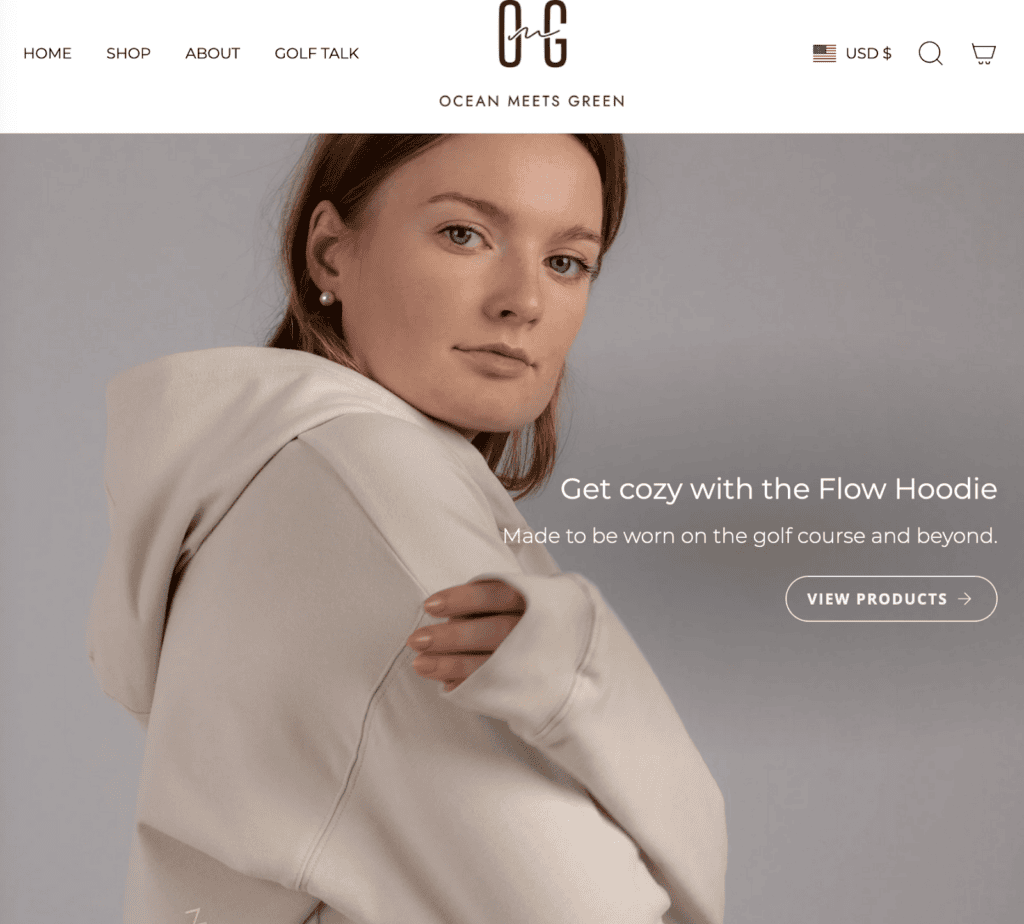
“Ocean Meets Green is part of the change for a more transparent and sustainable clothing industry by creating eco-conscious golf wear handcrafted ethically in Poland.”
Ocean Meets Green
🌎
How do they ensure their sustainability?
Ocean Meets Green prioritizes sustainability by using eco-friendly materials for fabrics and components.
- Their MOANA polos and TIDE skirts are made with 100% ECONYL® regenerated nylon yarn. ECONYL® is made from recovering nylon waste such as old fishing nets, fabric scraps, or carpets, helping reduce (ocean) waste. Their hoodies are made with 95% organic cotton certified by GOTS and 5% elastane certified by OEKO-TEX® STANDARD 100.
- Additionally, the brand sources corozo seeds as raw materials for their buttons. Corozo trees grow in the wild, and their seeds are renewable, making a more eco-friendly button material than, for example, plastics.
- Regarding packaging, Ocean Meets Green also opts for eco-conscious options, including compostable plant-based mailer bags, 100% compostable and recyclable shipping labels, and 100% compostable, acid-free, printed with soy-based ink and 100% FSC-certified tissue paper and stickers.
🌐
How do they ensure their ethics?
Ocean Meets Green ensures their ethics by partnering with a small family-owned sewing studio they can visit in person.
🤝
Are they part of any giving-back programs?
Ocean Meets Green is not known to be part of any giving-back programs.
🛍️
What is their product range?
- Best for: womenswear, menswear
- Product range: golf skirts, hoodies, polos
- Price range: $$$
- Size range: XS–XL
RADMOR: Better Solutions for Golf Apparel

“We are the first, and as of this writing, the only brand in the golf industry to avoid using ‘virgin’ polyester on a garment level. We’ve also limited the amount of recycled ocean polyester and recycled nylon we use to less than 15% of our collection, and always with the option of RAD-Cycling at the end of the product life-cycle.”
RADMOR
🌎
How do they ensure their sustainability?
RADMOR ensures their sustainability by sourcing low-impact materials for both textiles and packaging.
- Firstly, they prioritize natural fibers like BCI cotton and organic cotton. Where synthetic fibers are needed to enhance performance, the brand opts for the most environmentally sound options, such as certified recycled polyester, REPREVE® made from plastic bottles, or recycled nylon from discarded fishing nets.
- Their packaging materials are also eco-friendly. They have completely eliminated single-use plastics in their packaging and are using biodegradable, compostable, recyclable, and recycled materials instead.
- Furthermore, the brand creates durable, high-quality products that don’t need frequent replacement, thereby reducing consumption and waste.
🌐
How do they ensure their ethics?
Ethical manufacturing practices are at the heart of RADMOR’s production and sourcing process. This includes ensuring fair labor practices and minimizing waste during production.
🤝
Are they part of any giving-back programs?
RADMOR is not known to be part of any giving-back programs.
🛍️
What is their product range?
- Best for: menswear, womenswear
- Product range: polos, tees, layering, shoes, pants, denim, outwear, headwear, accessories
- Price range: $$
- Size range: XS–XL
Why Is It Important to Buy Products Made of More Sustainable Fabrics
It is important to buy products made of more sustainable fabrics because a sustainable textile industry has a lower carbon footprint, helps save natural resources, and is better for forests, animals, and humans.
Buying Sustainable Fabrics Reduces Your Carbon Footprint
The production of clothing and footwear is estimated to contribute 10% of global greenhouse gas emissions—more than all international flights and shipping combined. If the fashion industry were a country, it would be the fourth largest emitter of carbon dioxide.
One way to reduce the carbon footprint of the clothes you buy is to opt for sustainable fabrics. Sustainable fabrics, which are often made with natural or recycled fibers, have relatively low carbon footprints compared to petroleum-based fabrics. For example, organic cotton made in the US has a carbon footprint of 2.35 kg CO2 (per ton of spun fiber)—a quarter of polyester’s carbon footprint.
Buying Sustainable Fabrics Reduces Demand for Natural Resources and Waste Management
The textile industry uses water and land to grow cotton and other fibers. It is estimated that 79 billion cubic meters of water were used for the sector worldwide in 2015. For example, producing a single cotton T-shirt requires as much water as one person drinks for 2.5 years (2,700 liters of fresh water).
Worse yet, the textile economy is vastly more linear than circular: the largest amount of resources used in clothes ended up in landfills (instead of being recycled to remake clothes). According to a report by the Ellen MacArthur Foundation,
- Less than 3% of materials used in the textile economy in 2015 came from recycled sources.
- In other words, more than 97% of the resources used in making clothes are newly extracted.
When clothing items are disposed of within a short period of time—under a year in the case of half of the fast fashion clothes—the natural systems that provide raw materials for fabrics don’t have enough time to recover and regenerate, which could lead to ecological breakdown.
Sustainable fabrics are made with less water and emissions while lasting longer:
- Because they are durable, you don’t need to buy new clothes too often.
- Thus, you help reduce the pressure to extract more resources for making new items.
Similarly, making and consuming sustainable fabrics made with recycled materials reduces the demand for virgin materials while helping tackle waste management.
Buying Sustainable Fabrics Encourages Sustainable Management of Forests
Sustainable natural fiber fabrics are made with raw materials from forests and plantations that are sustainably managed, such as complying with FSC standards.
When you buy sustainable natural fiber fabrics, you discourage unsustainable forestry practices like illegal logging. You can help reduce deforestation, biodiversity loss, and the effects of climate change.
Buying Sustainable Fabrics Encourages Fairer Treatment of Animals
The fashion industry is rife with animal mistreatment when it comes to making animal-based fabrics like wool or silk. Every year, billions of animals suffer and die for clothing and accessories.
Buying sustainable vegan alternatives can help to reduce the pressure on raising more and more animals to meet the demand for animal-based fabrics while sacrificing their well-being and lives.
Suppose you have to buy fabrics made with, for example, wool or silk; make sure you only choose brands committed to cruelty-free products. In that case, you help advocate better treatments for animals raised within the textile industry.
Using Sustainable Fabrics Encourages Fairer Treatment of Textile Workers
Recent statistics from UNICEF estimated as many as 170 million child laborers worldwide, many of whom were engaged in some form of work in the textile industry. They don’t get paid minimum wages and often work long hours.
When you buy sustainable fabrics from brands transparent about the working conditions at their factories, you discourage the use of child labor and help promote better working conditions for textile workers.
How Can You Generally Buy More Sustainable Fabrics
The key to sustainably buying fabrics is to check on relevant environmental and original certifications.
For natural fabrics:
- Global Organic Textile Standard (GOTS): A globally recognized certification system that ensures a certain threshold of organic content has been met. It covers manufacturing, packaging, labeling, transportation, and distribution (but not what happens in the fields where crops are grown).
- USDA Certified Biobased Product: The USDA BioPreferred® Certification is a voluntary certification offered by the United States Department of Agriculture. The certification identifies products made from plants or other renewable materials.
- Ecolabel: Ecolabel is the official European Union voluntary label recognized worldwide for certified products with a guaranteed, independently verified low environmental impact. The label requires high environmental standards throughout the entire life-cycle: from raw material extraction through production and distribution to disposal. It also encourages companies to develop innovative, durable, easy-to-repair, and recyclable products.
For natural fiber semi-natural/semi-synthetic fabrics:
- Forest Stewardship Council: An FSC certification ensures that the wood (or wood-like material) comes from responsibly managed forests that provide environmental, social, and economic benefits.
There are two types of FSC Certification:- FSC Forest Management Certification, with a focus on the origin of the wood—the forest.
- FSC Chain of Custody Certification, which focuses on the path from the forest to the customer’s home.
- Program for Endorsement of Forest Certification: PEFC’s approaches to sustainable forest management are in line with protecting the forests globally and locally and making the certificate work for everyone. Getting a PEFC certification is strict enough to ensure the sustainable management of a forest is socially just, ecologically sound, and economically viable but attainable not only by big but small forest owners.
For recycled fabrics:
- Recycled Claim Standard (RCS): The Textile Exchange RCS was originally developed as an international, voluntary standard that sets requirements for third-party certification of Recycled input and chain of custody.
- The Global Recycled Standard (GRS): The Global Recycled Standard (GRS) is an international, voluntary, full product standard that sets requirements for third-party certification of Recycled Content, chain of custody, social and environmental practices, and chemical restrictions. It can be used for any product with more than 20% recycled material.
For all types of fabrics:
- STeP by OEKO-TEX®: STeP by OEKO-TEX® is an independent certification system for brands, retailers, and manufacturers from the textile and leather industry. It communicates organizational environmental measures, including reducing carbon footprint and water usage.
- OEKO-TEX® Standard 100: OEKO-TEX® labels aim to ensure that products pose no risk to human health (i.e., containing banned chemicals).
Some certifications that are signaling brands’ efforts toward lowered environmental impacts and a circular economy are:
- B Corp Certification: The label B Corp is a certification reserved for for-profit companies. Certified holders are assessed on their social and environmental impacts.
- Cradle2Cradle certification: Cradle2Cradle provides a standardized approach to material circularity. It assesses whether products have been suitably designed and made with the circular economy in mind covering five critical categories: material health, material reuse, renewable energy and carbon management, water stewardship, and social fairness.
Final Thoughts
Golf apparel can have a high environmental impact due to its frequent washing needs and its conventional use of high-impact synthetic fabrics for stretch and moisture wicking. Thus, it is important to shop with ethics and sustainability in mind when choosing your next polo.
By purchasing golf clothing from brands that commit to sustainability, you support their mission to create a fairer and less harmful textile industry for all lives on Earth.
Here is the list (again) of the most sustainable golf clothing brands:
- Reflo
- Definite Articles
- Galvin Green
- Allbirds
- Tentree
- WYLD1
- Ocean Meets Green
- RADMOR
To make your use of these clothing items even more sustainable, follow these steps:
- Buy second-hand, recycled, or upcycled golf apparel made with low-impact materials.
- Keep your golf apparel for as long as possible.
- At the end-of-life of your golf apparel, upcycle the materials to extend their usage and arrange for them to be recycled or properly disposed of.
Stay impactful,

Sources
- Impactful Ninja: How Sustainable Are Synthetic Fabrics? A Life-Cycle Analysis
- Reflo: Home
- Definite Articles: Home
- Galvin Green: Home
- Allbirds: Home
- Tentree: Home
- WYLD1: Home
- Ocean Meets Green: Home
- RADMOR: Home
- Reflo: Carbon Offsetting
- Reflo: Golf Edit
- Reflo: Fabric Technology
- Impactful Ninja: How Sustainable Are Recycled Polyester Fabrics? A Life-Cycle Analysis
- Textile Exchange: Global Recycled Standard
- Bluesign: Home
- OEKO-TEX: Home
- Reflo: Active RegenerationTM
- Reflo: Reloop collection
- Reflo: Reloop
- Ecologi: Producing energy from waste rice husks in India
- Ecologi: Cleaner cookstoves in Zambia and Ghana
- Reflo: Production Partners
- Amfori: BSCI
- Reflo: Our Forest
- B Corporation: Definite Articles
- Definite Articles: Sustainability
- OEKO-TEX: Home
- Impactful Ninja: How Sustainable Are Nylon Fabrics? A Life-Cycle Analysis
- Impactful Ninja: How Sustainable Are Polyester Fabrics? A Life-Cycle Analysis
- Impactful Ninja: How Sustainable Are Lyocell Fabrics? A Life-Cycle Analysis
- Definite Articles: Supplier Code of Conduct
- International Labor Organization: ILO’s Declaration on Fundamental Principles and Rights at Work
- GolfDigest: What does “sustainability” mean in golf fashion?
- Galvin Green: Sustainability
- Galvin Green: Our materials
- Galvin Green: Product care
- Galvin Green: GORE-TEX SHAKEDRY™ TECHNOLOGY
- Galvin Green: INTERFACE-1™ WARMING EFFECT #1
- Galvin Green: SKINTIGHT™ THERMAL
- Sustainable Golf: Galvin Green advances its eco-friendly UpCycle Edition
- B Corporation: Allbirds
- Allbirds: Golf Dasher
- Allbirds: Sustainability Guide & Practices
- Allbirds: What’s in a Footprint | Sustainability Practices
- Allbirds: Carbon OffsetsSustainability Practices
- Allbirds: Renewable Materials | Sustainability Practices
- Allbirds: Regenerative agriculture | Sustainability Practices
- Allbirds: Responsible energy | Sustainability Practices
- Impactful Ninja: How Sustainable Are Recycled Fabrics? A Life-Cycle Analysis
- Impactful Ninja: How Sustainable Are Synthetic Fabrics? A Life-Cycle Analysis
- Allbirds: Our Materials | SUGAR
- Allbirds: Trail Runners SWT
- Allbirds: Tree Flyer
- Allbirds: Our Story
- Impactful Ninja: How Sustainable Are Merino Wool Fabrics? A Life-Cycle Analysis
- Allbirds: What is your commitment to sustainability?
- Allbirds: M0.0NSHOT
- Allbirds: Allbirds ReRun™
- Allbirds: Supplier Code of Conduct
- ILO: Labor Standards
- Allbirds: How We Operate
- Allbirds: Tier 1 Suppliers
- Allbirds: Animal Welfare Policy
- Discovery ZQ: Home
- Soles4Souls: Home
- The Robin Report: Allbirds: Pioneering Sustainable Footwear
- Tentree: Women’s Sustainable Activewear
- Tentree: Men’s Sustainable Activewear
- Tentree: Tree Planting FAQ
- Tentree: Circularity By tentree
- Tentree: Our Materials
- Tentree: Thinking Outside the Box
- Tentree: WE’RE TENTRE | We Believe Big Change Starts Small.
- SuperCircle: Home
- Treet: Home
- Tentree: SuperCircle
- Impactful Ninja: How Sustainable Are Organic Cotton Fabrics? A Life-Cycle Analysis
- Impactful Ninja: How Sustainable Are Hemp Fabrics? A Life-Cycle Analysis
- Impactful Ninja: How Sustainable Are Recycled Polyester Fabrics? A Life-Cycle Analysis
- Impactful Ninja: How Sustainable Are TENCELTM Fabrics? A Life-Cycle Analysis
- Tentree: InMotion Zip Polo
- REPREVE: Home
- Tentree: Eco-friendly socks
- Tentree: Responsible Packaging
- B Corporation: Tentree
- CLIMATE NEUTRAL: Tentree
- Tentree: Ethical Manufacturing
- Good On You: Brand Directory | Tentree
- Fair Wear Foundation: Home
- Sedex Members Ethical Trade Audit: Home
- Worldwide Responsible Accredited Production – WRAP: Home
- Shopify: Ten Tree International Inc. (tentree) | Commitment to Protect Forests Through Our Paper, Packaging and Fabrics Choices
- Tentree: THE ENVIRONMENTOR | Here’s Where We Plant Your Trees
- Tentree: 04 nature | TENTREE SUSTAINABILITY
- WYLD1: DRIVEN BY NATURE
- WYLD1: Sustainable Fabric Science Innovation
- Impactful Ninja: How Sustainable Are Merino Wool Fabrics? A Life-Cycle Analysis
- Sewport: What is Pima Cotton: Properties, How its Made and Where
- The Sustainable Fashion Collective: fOCUS ON FIBERS: SUSTAINABLE SEAWEED FABRIC…SEACELL
- Pachama: Acapa – Bajo Mira y Frontera Forest Conservation Project
- Bluesign: Home
- WRAP Compliance: Home
- Textile Exchange: Global Recycled Standard
- Global Organic Textile Standard (GOTS): Home
- OEKO-TEX: Home
- WYLD1: The First Tee
- Impactful Ninja: How Sustainable Are ECONYL Fabrics? A Life-Cycle Analysis
- Ocean Meets Green: What is ECONYL Regenerated Nylon?
- Ocean Meets Green: Women’s Hoodies
- Impactful Ninja: How Sustainable Are Organic Cotton Fabrics? A Life-Cycle Analysis
- Global Organic Textile Standards: Home
- Impactful Ninja: How Sustainable Are Elastane Fabrics? A Life-Cycle Analysis
- OEKO-TEX: OEKO-TEX® Standard 100
- Ocean Meets Green: Sustainability
- Impactful Ninja: How Sustainable Are Natural Fabrics? A Life-Cycle Analysis
- Better Cotton: Home
- Impactful Ninja: How Sustainable Are Organic Cotton Fabrics? A Life-Cycle Analysis
- Impactful Ninja: How Sustainable Are Recycled Polyester Fabrics? A Life-Cycle Analysis
- Impactful Ninja: How Sustainable Are Recycled Nylon Fabrics? A Life-Cycle Analysis
- European Parliament: The impact of textile production and waste on the environment (infographic)
- Science Direct: The challenge of “Depeche Mode” in the fashion industry – Does the industry have the capacity to become sustainable through circular economic principles, a scoping review
- Science Direct: Carbon Footprint of Textile and Clothing Products
- European Parliament: Environmental impact of the textile and clothing industry
- European Parliament: What if fashion were good for the planet?
- Ellen MacArthur Foundation: A New Textiles Economy: Redesigning fashion’s future
- McKinsey: Style that’s sustainable: A new fast-fashion formula
- Forest Stewardship Council: Home
- Our World in Data: Deforestation and Forest Loss
- Our World in Data: Renewable Energy
- Peta: Animals Used For Clothing
- The Guardian: Child labour in the fashion supply chain
- Impactful Ninja: How Sustainable Are Natural Fabrics? A Life-Cycle Analysis
- Global Organic Textile Standard (GOTS): Home
- BioPreferred: WHAT IS THE BIOPREFERRED PROGRAM?
- European Commission: Environment | EU Ecolabel
- Impactful Ninja: How Sustainable Are Semi-Natural/Semi-Synthetic Fabrics? A Life-Cycle Analysis
- Forest Stewardship Council
- FSC Forest Management Certification
- FSC Chain of Custody Certification
- Textile Exchange: The RCS and GRS are designed to boost the use of recycled materials
- Program for Endorsement of Forest Certification
- Impactful Ninja: How Sustainable Are Recycled Fabrics? A Life-Cycle Analysis
- Textile Exchange: Recycled Claim Standard
- Textile Exchange: Global Recycled Standard
- OEKO-TEX: Certification according to STeP by OEKO-TEX®
- OEKO-TEX: OEKO-TEX® Standard 100
- B Corp Certification: Home
- C2CCertified: Home















